Conceptualizing the Future of US Special Operations
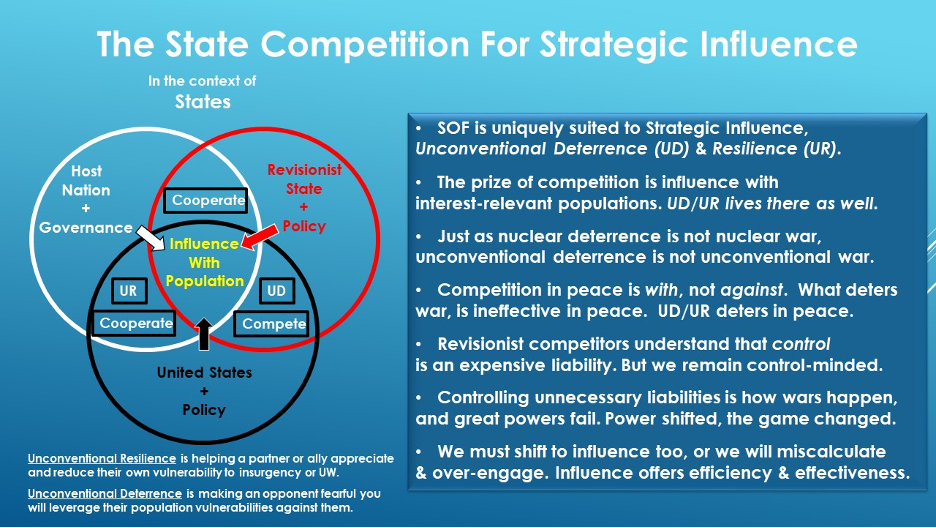
Conceptualizing the Future of US Special Operations
Colonel (Retired) Robert C. Jones
What are the operations we need to select, train, organize and equip the force to conduct that are truly “Special” and also relevant to the challenges facing our nation in this evolving strategic environment?
This is the most important question facing United States Special Operations Command today. But it’s not one we spend much time on. The expectation is simple: maintain our exquisite CT capability, reinvest in historic missions across the SOF service components, and incorporate the latest technologies. But is that answer actually “special?” Truthfully, that answer might not even be adequate.
To answer this question demands a multi-discipline approach. One must first question assumptions made in the NDS about the role of SOF. Next, one must appreciate the fundamental nature of the rapidly changing strategic environment, and how those changes are affecting both our national interests and the character of threats to those interests. Then, one must truly understand the full breadth of special operations forces (SOF) and missions; which goes far beyond the hyper-conventional operations that have come to define the post-9/11 era. Those missions (high-end raiding and partner capacity building) will always play an important role in SOF. The high-end tactical actions SOF is famous for will remain a world-class part of what we do. Likewise with our unique ability to work with indigenous forces. In the emerging environment, however, the most vital and special roles for SOF lies elsewhere.
The main effort for the emergent future is within a human domain the Joint Force refuses to recognize, and conducting operations currently undefined by doctrine. Historic approaches and future technologies will continue to shape the future of SOF, but the answers we seek lie in less charted ground. Information technology has made the human domain more relevant than at any time in history. For SOF, humans are not merely a consideration we must take into account; for SOF, humans are the very medium we operate within and through. The future of SOF is in the competition for strategic influence. This is the ultimate “hearts and minds” campaign – working our way into the hearts of the populations and governments we operate among, and into the minds of those who would do us harm. This holds true equally for achieving durable, desired strategic effects with state actors as it does with non-state actors.
Main Ideas.
- The strategic environment is characterized by rapidly shifting power and destabilizing competition and conflicts between status quo and revisionist actors.
- Current strategic guidance is to be better at competition, focusing on five actors. SOF is to carry the burden on VEOs, while the services shift focus to state actors.
- Historically, SOF plays a minor, but important role in major power deterrence and conflict. However, SOF is uniquely suited to create a powerful new form of unconventional deterrence that promises far better results than traditional approaches against problematic competition.
- SOF is very good at CT, but CT is proven strategically ineffective and unsustainable in resolving the problem of modern VEOs. By reframing the problem and shifting to a Counter-Unconventional Warfare approach, SOF has an opportunity to generate more durable strategic effects, and free up the SOF capacity necessary to operationalize unconventional deterrence.
The Strategic Environment. As the preeminent status quo power, the US finds itself particularly challenged by the heightened competition between those who see their interests served best by preserving some semblance of the status quo, and those revisionist actors who see their interests served best by change. In an era characterized by rapidly shifting power, both between states, and also between populations everywhere and the various sources of governance affecting their lives, there is tremendous potential energy for conflict and chaos – and in chaos, lies opportunity.
Those who most effectively understand, leverage or reduce this destabilizing energy will be best postured to prevail in competition; to avoid the devastating costs of war abroad; and mitigate instability at home. Revisionists are naturally better postured to see opportunity in this chaotic environment, but a status quo power who can think like a revisionist can chart a proactive course and avoid the slow attrition of reactive approaches. We must appreciate the United States government has no right of leadership, rather it is granted a duty to lead by those willing to follow (as true at home as abroad). To sustain a prominent position demands evolving to a more pragmatic, flexible and sophisticated leadership style. This requires assuming greater risk in giving up control of things no longer essential to interests, and enhancing those forms of influence so essential to national power in today’s rapidly evolving world. Control has become an obsolete and expensive liability. We are in an era of influence.
Strategic Guidance. The NDS directs that deterring or winning wars is no longer adequate. The military must also serve to facilitate success in competition short of armed conflict. Our greatest challengers currently are China, Russia, Iran, North Korea and Violent Extremist Organizations (VEO). Focus on them.
But here is a fundamental flaw in the National Defense Strategy (NDS): The Services see the strategy as permission to step away from VEO missions to focus on state challengers; leaving SOF to clean up an irregular mess. But most counter-VEO operations are largely conventional, and the Services are largely unsuited to deterring the problematic acts of disruptive state competition occurring beneath the threshold of traditional deterrence. People are quick to associate irregular warfare with irregular threats, and both with SOF. This is a mistake. All must incorporate irregular warfare across the entire spectrum of threats, but completely unstated anywhere is that Irregular warfare is a conventional mission and a misapplication of SOF. What SOF conducts are Special Operations, and Special Warfare [i]– unique and discrete subsets of irregular warfare, falling across all manner of threats, in peace and war. To fully realize the NDS, SOF must fight for relevant missions and evolve to relevant abilities. In short, SOF must become more special. SOF will only be able to optimize its role, however, if the services maintain theirs.
SOF and State Challengers. In traditional war, SOF historically plays an important, but minor role. While no major revision of core activities is needed, we must adjust our ability to conduct those missions to the unique challenges of the emergent environment. Adding to the challenge is that over the past 18 years US SOF has devolved. Once a sophisticated toolkit; much like a maker of fine watches might roll out on the workbench before him. Now we are little more than a bag of hammers. Big to small and wielded with élan and skill – but hammers all the same. SOF must return to sophistication. Each tribe must return to its roots, and then, like Apple, “abandon successful products and flee into the future…”
There are tremendous challenges across all of the core missions, but frankly, there is tremendous effort focused on most of those missions as well. The current situation, however, is competition. Competition is peace, and the mission in competition is deterrence. Historically, SOF plays an even smaller role in the deterrence of war than in its conduct. However, SOF is uniquely suited to create a new way of deterring the competition short of armed conflict currently taking place largely unhindered below the threshold of traditional deterrence. Very much like France’s Maginot Line – it matters little how magnificent we make our deterrence, if the enemy simply goes around. SOF can fill this gap, and help lower the threshold.
The most important factor common to the named state challengers is that all four are autocratic regimes premised in the idea that governments control populations. While effective in appearance, these regimes grow increasingly brittle with every act of excessive control, and are far more fearful of the populations they impact than they are of any foreign military. SOF has a unique opportunity to leverage the principles of Unconventional Warfare (UW) to create a powerful new deterrent effect. To this end, SOF should embrace a global campaign of Strategic Influence, with a focus on Unconventional deterrence (UD). This is not only a powerful new form of deterrence, it is also an important element of campaigning to foster positive influence. America rose to leadership because others believed in the power of what we were for; when America falls from power it will be because we came to be known more for what we fear. We compete for strategic influence – an intangible commodity facilitating our own good policy, mitigating our policy miss-steps and a hedge against the competing policies of others.
Doctrine aside, in fundamental terms, UW is essentially any effort to leverage the insurgent energy in a population governed by another in order to advance one’s own interests. The actions of our competitors are unconstrained by our doctrine, even if our own thinking is. Russia, Iran, al Qaeda and ISIS are all masters of the fundamentals of UW and conduct sophisticated campaigns designed to provoke inappropriate over-reactions, deplete our influence and challenge our interests. The aspect of C-UW most appropriate to state actors is deterrence, and the form of deterrence most appropriate to competition short of armed conflict is unconventional deterrence. Unconventional deterrence is also a form of Psychological Warfare, as the goal is to create a credible threat of UW, not to actually conduct UW. Deterrence occurs when one’s opponent believes the potential costs of an action exceed the potential gains. Unlike traditional approaches to deterrence, unconventional deterrence allows the creation of a deterrent effect with far less risk of escalation. An irony of traditional deterrence is that in competition it allows our opponents to run free, while we deter ourselves from responding for fear of escalating a situation into a war no one wants. Unconventional deterrence is less likely to escalate.
Critics of unconventional deterrence invariably conflate it with an overly simplistic appreciation of unconventional warfare itself. Unconventional Deterrence is not Unconventional Warfare any more than Nuclear Deterrence is Nuclear Warfare. The foundations of Unconventional Deterrence lie in benign, transparent actions among the populations most critical to competition. In the near term these actions build the language skills and cultural awareness of our SOF. Over time they enhance the understanding, influence and relationships fundamental to special operations in general. These actions also serve to “heap burning coals” on the heads of those we hope to deter. This is no place for first order thinking. This is a form of strategic indirect approach, and is indeed, “more intellectual than a bayonet charge.”
The goal of unconventional deterrence is not to destabilize the societies of our enemies. The goal of unconventional deterrence is to deter our enemies from destabilizing our own society, and those of our allies and partners. A global unconventional deterrence campaign will not demand larger SOF forces or a larger SOF budget. A global campaign will take place nearly entirely in permissive spaces and involve influence-building activities among populations essential to the developing competition. A global campaign will be far more respectful of the sovereignty of our allies and partners as well and avoid placing demands to act in ways counter to their own interests as we seek their help in the pursuit of our own. A global campaign will also take a page from our opponents, leveraging modern technologies and engaging the world as it actually is, rather than doing so in a manner overly shaped by our fears or bias; or constrained by our doctrine. We need not control or contain; we need understanding and influence.
The companion line of effort to the unconventional deterrence directed at those we seek to deter, is unconventional resilience, conducted to help immunize ourselves, our partners and allies from the UW efforts of others. After all, populations are radicalized far more by the governance affecting their lives than they are are by the extreme narratives of malign actors. Be it the Salafist ideology of AQ and ISIS, or extremes of left and right narratives applied by domestic groups. These are catalysts, not causation.

Figure 1. SOF and State Challengers.
SOF and Violent Extremist Organizations. Counterterrorism (CT) is a reactive, symptomatic approach; exaggerating the role of ideology and failing to produce durable, desired strategic results. CT is an unsustainable strategy for our nation, and by and large is not even a special operation. However, by reframing our understanding of how insurgency and UW manifest in the current strategic environment, we can reframe our solutions as well. Counter-Unconventional Warfare (C-UW) offers a framework promising to be far more holistic, appropriate, durable and sustainable than CT. But before we can fully embrace evolving from CT to C-UW, we must first change how we think about the problem, moving forward from several deeply flawed and calcified assumptions we have come to accept as fact.
Most individuals and organizations currently branded as “terrorists” (a term with no strategic meaning) are more accurately revolutionary insurgents. A small few are also UW operatives for AQ or ISIS. These insurgents may accept assistance from VEOs conducting UW; and they may travel and fight in support of VEO UW campaigns; but their respective revolutionary insurgencies are their raison d’etre. The United States must get out of the business of capturing and killing the insurgent populations of others.
Outdated Western foreign policies already create the energy for resistance insurgency relied upon by AQ and ISIS to bind these disparate revolutionary populations to common purpose. In the current strategic environment one need not physically occupy a foreign nation (though we do) to create a resistance effect; one need only occupy by policy (which we definitely do). Similarly, building CT capacity in our Allies and Partners designed to enable them to capture or kill their own insurgent populations more effectively enables their impunity and is counterproductive to the interests of our country. SOF must avoid the urge to confuse doing something well, with something also doing good. Or, said another way, we must stop celebrating our tactical successes, while rationalizing away our strategic failures.
When we counter the UW campaigns of VEOs like AQ and ISIS, we shift from being against a symptom we fear, to being for an end state far more can rally around. Ultimately, we are competing for strategic influence across the full spectrum of actors in the spaces where our interests manifest. C-UW recognizes that VEOs conduct UW campaigns and focuses on defeating their strategy, while at the same time out-competing them for influence with the insurgent populations they rely upon. C-UW narrowly focuses CT on UW operatives and foreign fighters. C-UW employs UW approaches to create lines of influence with insurgent groups and populations, offering better alternatives for addressing their grievances with governance. A C-UW campaign employs forces and capabilities across the SOF enterprise, and employs many of our existing core activities. What makes C-UW unique is how it reframes the problem and repurposes and prioritizes SOF activities for greater strategic effect, and in ways that are truly special.
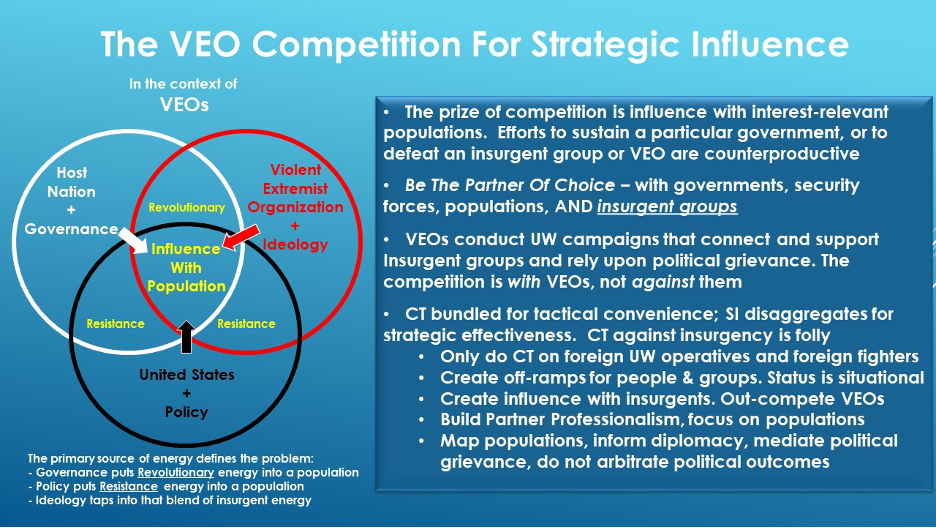
Figure 2. SOF and VEO Challengers.
Concluding Thoughts.
To meet the rapidly evolving security challenges associated with the emerging strategic environment, and to meet and exceed the guidance of the National Defense Strategy, SOF must be willing to make changes that are equally significant. The current focus on counterterrorism is neither strategically successful nor sustainable. Though most CT missions are largely conventional, many will argue that is where SOF must focus. This is an area where the NDS misses the mark. We must all evolve in how we think about the entire family of threats identified in the NDS. The services are right to focus on the deterrence of war and the preparation for war. But we must recognize the limitations of traditional deterrence against problematic acts of state competition. Many will argue SOF has no role there, and is no more than a hyper-tactical tool. Most who make that argument are not special operators themselves.
The reality is that SOF is uniquely suited to create a new layer of unconventional deterrence that promises to shore up our inability to deter unwanted competition short of armed conflict. Evolving from a CT framework to a C-UW framework also promises to increase the strategic effectiveness of SOF against VEOs in a manner that is far more sustainable. The efficiencies created by this evolution will free up the capacity necessary to develop this emerging unconventional deterrence mission.
The understanding associated with these UW-based concepts also helps to facilitate a parallel evolution of approaches across US policy and diplomacy. We will find less need to employ the military to compel policy compliance once we recognize we serve our interests best by leveraging our power to foster influence, rather than to exercise control. We must adopt a mediator mindset, firmly insisting that difficult issues be addressed; and retire our urge to arbitrate; picking winners and losers, and trapped for years in the thankless, provocative task of enforcing our decisions and cleaning up our mistakes.
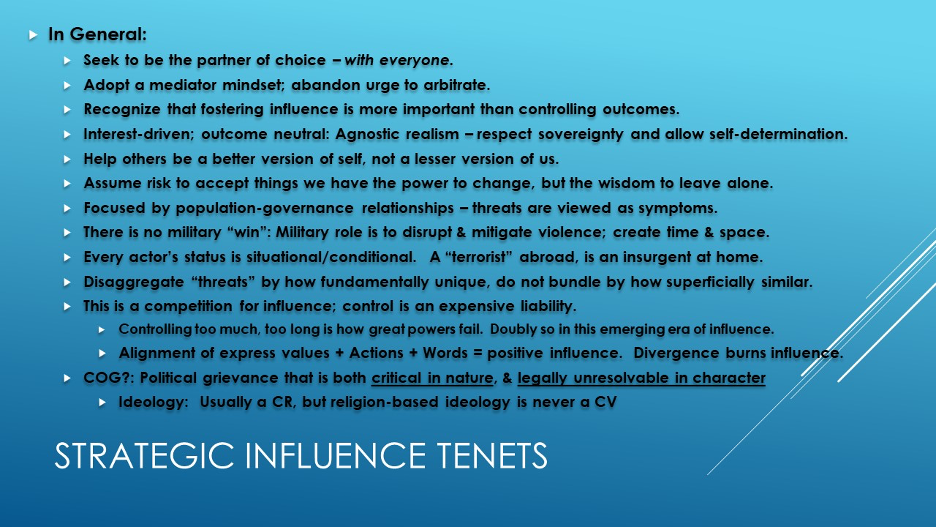
Figure 3. Strategic Influence Tenets
Some Supporting Insights:
VEOs: During our application of a CT approach the VEO problem has doubled in size. We attack forces and locations; rather than alliances and strategies. A switch to a C-UW approach inverts that focus. We must disaggregate problems by how they are strategically unique, not bundle them by how they are tactically similar – particularly if it is a futile effort to fit a problem to our existing authorities for action, or preferred solutions.
- Causation: Recognize governance, not ideology, as cause. Security forces can only help mitigate and disrupt violence while creating time and space for governance (local and our own foreign polices) to evolve. Cold War/Colonial logic, coupled with fear of “abandoning allies” enables partner impunity.
- Center of Gravity: populations perceiving themselves in conditions of legally irreconcilable political grievance are the energy the system. Only evolution of governance can reduce that energy.
- Narrow CT: Only do CT on UW operatives and foreign fighters. Do not kill, or help kill, the insurgent populations of partners and allies (with rare exception). The former disrupts their UW campaigns; the latter enables a sense of impunity, hindering the governance evolution process.
- Status: Recognize that status is situational. A UW operative on the road, is an insurgent at home.
- Create off-ramps: Campaigns must encourage insurgents to stay home and come in from the cold, to address grievances with our assistance and within the rule of law.
- Illegal Democracy: Take those individuals and organizations who are primarily nationalist insurgents off the terror lists. What we bundled to target in CT, we must disaggregate to resolve in C-UW.
- Robin Sage: Conduct UW with insurgent groups. Establish rapport with the G-Chief and be the partner of choice for getting to better governance. If we refuse to be the bank of good governance, then desperate populations will turn to the loan sharks of rebellion. We must outcompete VEOs for influence with the disenfranchised populations and organizations their campaigns rely upon.
- Host Nation Forces: Build Partner Professionalism (BPP), not CT capacity, with host nation security forces. We have done this to good effect in the Philippines and Colombia, where we valued and respected the HN sovereignty over our own fear of competing ideology.
- Host Nation Government: No blank checks. We want to be perceived as the partner of choice, but must not become an obstacle between a population and their government. We must think like a mediator, not an arbitrator. No one likes tough love, but we all at times need it.
- Host Nation Populations: Map out by critical identities. Assess critical perceptions (circle of trust). Help to create greater resilience by guiding programs to address failures of governance.
- Partners and Allies: By disaggregating problems into strategically similar groupings for tailored engagement, it makes it easier to match partners and allies up with aspects of a problem meeting their unique capabilities and that are perceived as appropriate by their own populations at home.
State Actors. SOF is unlikely to be decisive; but the current strategic environment is creating the opportunity for SOF to create a new, powerful line of deterrence that is effective during competition in ways that traditional approaches to deterrence cannot do. Unconventional Deterrence is not UW, just like Nuclear Deterrence is not Nuclear War.
- Build Transparent Trust, not Clandestine Networks. For this to work it must be largely transparent and above board. Trust with the host. Trust with State. Trust with the Agency. Our opponents will never believe we are only doing what we appear to be doing. We leverage their paranoia to deter.
- Understanding, Influence, & Relationships. SOF must be “outside the wire” among the critical populations where our interests manifest; operating in permissive space to create strategic effects in denied space. This is the basic foundation for nearly everything SOF does that is truly special
- Unconventional Deterrence. Conduct psychological warfare, and seek to create a credible threat of UW. Transparent actions directed at what competing autocrats fear, value, and believe we will do.
- Brittle States. Autocratic regimes are increasingly more fearful of their own populations than they are of our military power. Many are “Titanic’s”, seemingly unsinkable, yet tragically vulnerable.
- Encourage Good Governance. (To our enemies, here is how you render this concept moot) The best defense for autocratic regimes is to conduct their own resilience operations to improve perceptions of their own governance. If they opt instead to crack down on populations they will only make our influence stronger, and their own situation worse. Traditional deterrence encourages military escalation and population crackdowns. Unconventional deterrence encourages good governance.
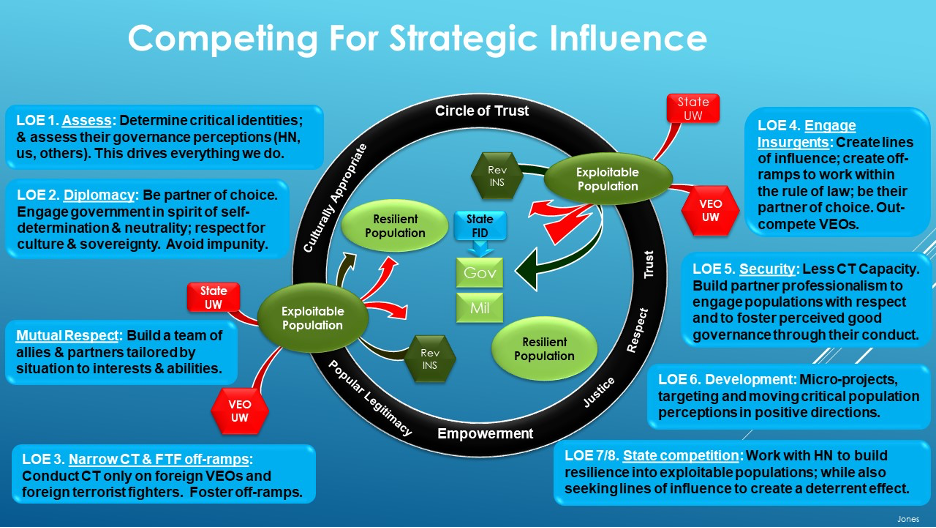
Figure 4. The Circle of Trust and Strategic Influence.
- Retention and Preparation. Benign actions in critical locations prepare our forces for whatever missions or situations may arise. This builds true agility and flexibility into SOF. Many will criticize these population-focused engagements as boondoggles. It’s ok to have fun while creating strategic effects. I envision SOF teams routinely traveling to their designated regions, and simply being out and among the people, working with trusted host nation partners and engaging in activities designed to build team cohesion and morale. If you are jealous, I can direct you to a SOF recruiter.
- Full-Spectrum. Conduct cyber infiltration from facilities at home; engage Diasporas wherever they reside, and seek those segments of target populations that extend from denied space into permissive space. Find the pressure points, and apply pressure. Engage the populations negatively affected by activities designed to advance adversary interests or to create nodes for strategic power projection. Empower and entrust our teams to leverage their creativity, training and experience. We have the best SOF in the world, but we waste their talents.
- Non-attribution and full credit. If we ever have to pull a string we can deny it. If instability happens of its own accord, we get credit. The gloves are off. We didn’t ask for this, but if you want to play rough, we will make you play our game on our terms.
Competition is peace, even if our opponents think it is war; a war they will lose – a peace we can win.
The thoughts, concepts and products included in this paper are my own, developed in over 30 years as a Special Forces qualified officer, both in uniform, and during the past 10 years as a Civilian strategist at USSOCOM. I first questioned the flaws in our CT logic and suggested shifting to a C-UW approach over 12 years ago. Few were ready for such an unconventional shift. I am the first to admit I have followed an eclectic path in life, and that my journey has revealed insights that are at times hard to see from more well-beaten paths. As a strategist I have both the duty and the privilege to think outside the lines. The leaders I respect and serve must deal with far more stringent parameters than I, and have a duty to operate within those same lines. If there were ever a time for all of us to think and act a bit more outside the lines, however, it is now. When in revolutionary times, think like a revolutionary.
Robert Jones is a retired Army Special Forces Colonel, serving the past ten years as senior strategist at USSOCOM. His focus is understanding the nature of the strategic environment, the evolving character of conflict, and the implications for our Special Operations Forces. He is a core member of the Joint Staff’s Strategic Multilayer Assessment (SMA) network, and a regular lecturer at the Joint Special Operations University and the Air War College. A Cold War and Gulf War vet, he stepped away for a bit to gain experiences as both an emergency manager and a deputy district attorney prior to returning to the Special Operations community post 9/11 to serve from Zamboanga to Kandahar, and places in between.
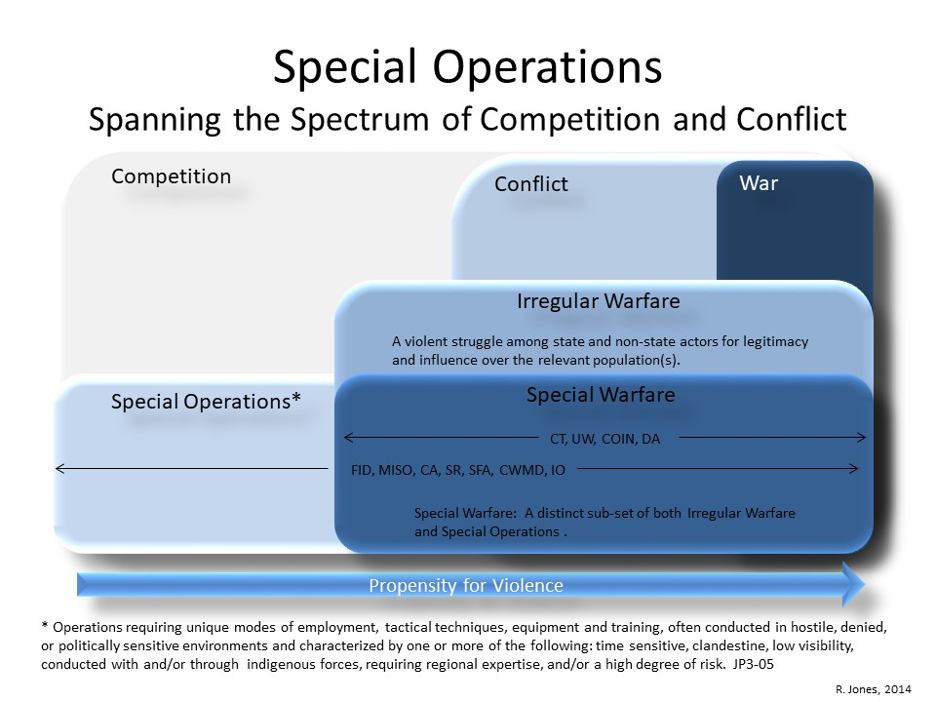
Figure 5. Author’s visualization of SOF across the spectrum of conflict, 2014. (Since the publication of the NDS, the definition of Irregular Warfare was modified to remove the violence requirement)
[i] See Diagram Above. Special Warfare is that subset of Irregular Warfare that is also a Special Operation. Argued here, is that on the far left end of competition, nothing is “warfare” at all, and what SOF conducts there are Special Operations; but as the propensity for violence increases more activities come into play and the overall operation morphs into Special Warfare. Doctrine, however, is in a state of flux, so this is the Author’s interpretation.






